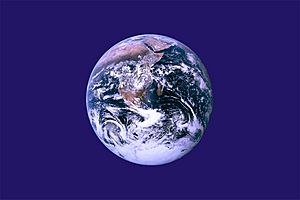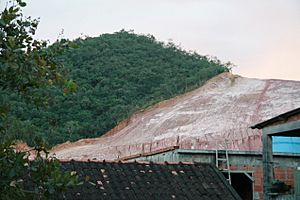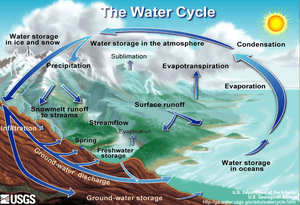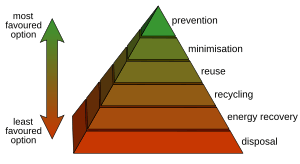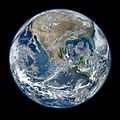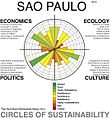Sustainability facts for kids
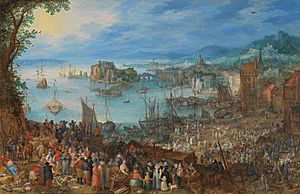
Sustainability means being able to keep something going at a certain level for a long time. When we talk about it in the 21st century, it usually means how humans and the Earth can live together without harming the planet for future generations.
Scientists who study ecology believe that sustainability happens when living things and their environment are in balance. To keep this balance, we must not use up resources faster than nature can make them again.
Healthy ecosystems and a good environment are super important for humans and all other living things. We can reduce our negative impact by using eco-friendly methods in chemical engineering, managing environmental resources, and protecting the environment. We learn about this from green computing, green chemistry, earth science, environmental science, and conservation biology. Ecological economics looks at how our economies and natural ecosystems are connected.
Living more sustainably can mean many things. It could be changing how we live, like creating ecovillages or sustainable cities. It could also mean changing how businesses work, like using permaculture or green building. We can also use science to invent new things, like green technologies and renewable energy. Or, we can simply change our own lifestyles to save natural resources.
Even though "sustainability" is a popular word, some people wonder if human societies can truly achieve it. This is because of problems like environmental degradation, climate change, using too many resources (overconsumption), a growing population, and societies always wanting more economic growth on a planet with limited resources.
Contents
Protecting Our Environment
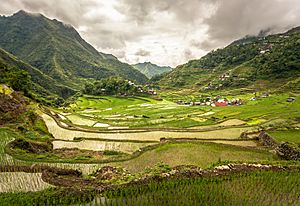
Healthy ecosystems give us important things and services, like clean air and water. There are two main ways to reduce human harm and improve these ecosystem services. One big way is through environmental management. This approach uses information from earth science, environmental science, and conservation biology.
Managing the Environment
Environmental management can be applied to the whole planet, including the oceans, freshwater systems, land, and atmosphere. It can also be used for any smaller ecosystem, from a rainforest to your own garden.
Our Atmosphere
Managing the Earth's atmosphere now means looking at all parts of the carbon cycle. We want to find ways to deal with climate change caused by humans. This is a huge area of scientific study because of the possible big problems it could cause for nature and people.
Other human impacts on the atmosphere include air pollution in cities. Pollutants like nitrogen oxides, sulfur oxides, and other chemicals create photochemical smog and acid rain. Also, chlorofluorocarbons damage the ozone layer, which protects us from the sun.
Freshwater and Oceans
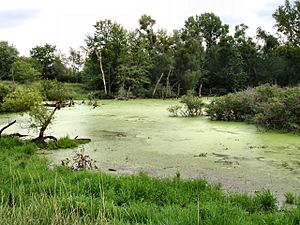
Water covers 71% of Earth. Most of it (97.5%) is salty ocean water. Only 2.5% is freshwater, and most of that is frozen in places like the Antarctic ice sheet. The rest of the freshwater is in glaciers, lakes, rivers, wetlands, soil, and the air. The water cycle constantly refills our freshwater supply. But there's still a limited amount, so we need to manage it carefully.
People have only recently understood how important it is to save water for ecosystem services. In the 20th century, over half of the world’s wetlands were lost. These wetlands provide valuable environmental services. More urbanization also pollutes clean water. Many people around the world still don't have access to clean, safe water. Now, there's more focus on managing water better, both the water we can collect (blue water) and the water in the soil for plants (green water).
Ocean currents greatly affect climate and weather, and this impacts our food supply. Scientists warn that climate change could suddenly change these ocean currents. This could drastically change the climate in some parts of the world. About 600 million people live in low-lying areas that are at risk from rising sea levels.
Land Use
Losing different kinds of plants and animals (biodiversity) mostly comes from losing their homes (habitat). How we use land is very important for the biosphere. Changes in how much land is used for cities (urbanization), agriculture, forests, and grasslands affect the global water, carbon, and nitrogen cycles. This can harm both nature and human systems. Locally, sustainable parks and gardens and green cities help a lot with sustainability.
Food is essential for life. Feeding over six billion people uses a lot of Earth’s resources. Problems with industrial agriculture are now being addressed by movements like sustainable agriculture and organic farming.
Managing What We Use
The main reason humans impact the environment is how much we consume. We can reduce this impact by using less and by making the whole process of making, using, and throwing away things more sustainable.
The main things humans need are food, energy, materials, and water.
Energy
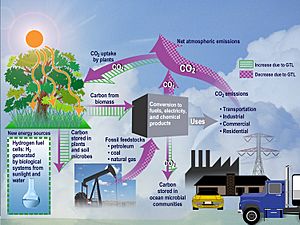
The Sun's energy is captured by plants during photosynthesis. This energy then moves through the food chain to other living things, powering all life.
Since the Industrial Revolution, the concentrated energy from the Sun, stored in ancient plants as fossil fuels, has powered much of our technology. This technology has also been a source of economic and political power. In 2007, climate scientists said there was a high chance (over 90%) that the increase in CO2 in the atmosphere was caused by humans. This is mostly from burning fossil fuels and, to a lesser extent, from changes in land use. To stabilize the world’s climate, rich countries will need to reduce their emissions by 60–90%.
Reducing greenhouse gas emissions is being worked on at all levels. This includes tracking carbon through the carbon cycle and developing renewable energy. It also means creating technology and transport systems that use less carbon. Individuals are also trying to live carbon neutral lifestyles by watching how much fossil fuel is used to make the goods and services they consume.
Water Use
Having enough safe water and enough food are closely linked. Between 1951 and 1960, humans used four times more water than in the previous decade. This fast increase was due to new science and technology, especially more irrigated land, growth in industries, and building many dams. This changed the water cycle of rivers and lakes, affecting their water quality and the global water cycle.
Currently, about 35% of human water use is not sustainable. We are taking water from shrinking underground water sources (aquifers) and reducing river flows. This percentage will likely grow if climate change gets worse, populations increase, and water supplies become polluted.
Water efficiency is improving globally. This includes managing demand better, improving water systems, and using water more productively in agriculture. We are also trying to reduce the "hidden" water used to make goods and services. People are becoming more self-sufficient locally by collecting rainwater and using less tap water.
Food Choices

The American Public Health Association (APHA) says a "sustainable food system" gives healthy food now. It also keeps ecosystems healthy so they can provide food for future generations with minimal harm to the environment. A sustainable food system also supports local food production and makes healthy food available and affordable for everyone. It is also fair, protecting farmers, workers, and communities.
Concerns about how big food businesses impact the environment, and the difference between obesity in Western countries and hunger in developing countries, have led to a strong movement towards healthy, sustainable eating. This is a big part of being an ethical consumer. How different diets affect the environment depends on many things, like how much animal or plant food is eaten and how the food was produced.
A Mediterranean diet is often recommended. It is linked to good health and longevity. It is low in meat, rich in fruits and vegetables, low in added sugar and salt, and low in saturated fats. The main source of fat in the Mediterranean diet is olive oil, which is rich in healthy fats. The traditional Japanese diet, based on rice, is also high in carbohydrates and low in fat. Both diets are low in meat and saturated fats, and high in legumes and other vegetables. They are linked to fewer health problems and less environmental impact.
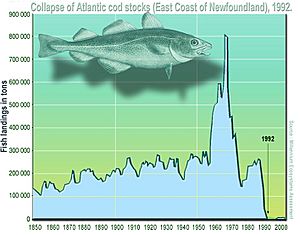
Globally, the environmental impact of big food businesses is being addressed through sustainable agriculture and organic farming. Locally, various movements are working towards local food production, using urban spaces and home gardens more productively. This includes permaculture, urban horticulture, local food, slow food, sustainable gardening, and organic gardening.
Sustainable seafood comes from fishing or farming that can continue or increase production in the future without harming the ecosystems. The sustainable seafood movement has grown as more people learn about overfishing and harmful fishing methods.
Materials, Chemicals, and Waste

As the global population and wealth have grown, so has the use of different materials. This includes raw materials, minerals, chemicals (some of them dangerous), manufactured products, food, and waste. By 2050, humanity could use about 140 billion tons of minerals, ores, fossil fuels, and biomass each year. This is three times the current amount! This will happen unless economic growth is separated from how fast we use natural resources. People in developed countries use an average of 16 tons of these four key resources per person. Some developed countries use 40 or more tons per person, which is far more than what is likely sustainable.
Sustainable use of materials aims for "dematerialization." This means changing the usual path of materials (take, use, throw away) into a circular flow. In this circular flow, materials are reused as much as possible, much like how waste is cycled in nature. This idea is supported by product stewardship and using material flow analysis more often. Using sustainable biomaterials that come from renewable sources and can be recycled is better than using non-renewable ones.
Making synthetic chemicals has increased a lot since World War II. Chemical production includes everything from weed killers, pesticides, and fertilizers to household chemicals and dangerous substances. Besides greenhouse gas emissions, other chemicals of concern include heavy metals, nuclear waste, chlorofluorocarbons, and persistent organic pollutants. All harmful chemicals that can build up in living things are a concern. Even though most synthetic chemicals are harmless, new ones need strict testing in all countries for bad effects on the environment and health. International laws have been made to deal with the global movement and management of dangerous goods.
Every economic activity creates material that can be called waste. To reduce waste, industries, businesses, and governments are now copying nature. They are turning the waste from industrial metabolism into new resources. Ideas like industrial ecology, ecodesign, and ecolabelling encourage dematerialization. Besides the well-known "reduce, reuse, and recycle," shoppers are also using their buying power for ethical consumerism.
Other pages
Images for kids
-
Changes in environmental conditions lead to coral bleaching and harm to biodiversity of fragile marine ecosystems.
See also
 In Spanish: Sostenibilidad para niños
In Spanish: Sostenibilidad para niños


